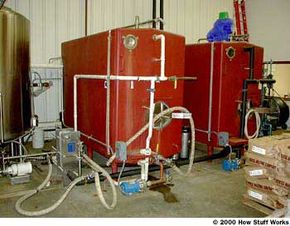Separating the Solids
Before the wort can go on to the next step, all of the solids must be separated from the liquid. This is done in a very neat way. The wort is pumped from the kettle, and forced back into the kettle through a jet nozzle. This flow of liquid causes a whirlpool to form; and if you've ever stirred tea leaves in a cup, you know that they move to the center of the whirlpool. When this whirlpool forms in the brew kettle, all of the hops and other solids move to the center. The pump is then turned off, and over the next 20 minutes the whirlpool gradually stops and the solids settle to the bottom, forming a fairly solid cone.
When the wort is drained, the solids stay in the kettle. Next, the wort must be cooled down to the proper temperature for the yeast. This is done in a liquid-to-liquid heat exchanger. The wort is circulated through one set of tubes while chilled water is circulated through another set. The tubes with hot wort running through them transfer heat to the tubes holding the chilled water.
Advertisement
The cooling water is chilled first, so that the volume of water that is required to cool down one entire batch of wort is about equal to the volume of wort. The cooling water ends up at a temperature of about 170 F (76 C), and is stored in an insulated tank and used to brew the next batch of beer. This way both the water and the heat energy are saved.
It is important to cool the wort quickly so that the yeast can be added right away and fermentation can begin. This reduces the chance of contamination by stray yeasts floating around in the air.
